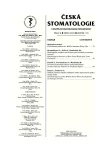Gunshot Injuries of the Middle Facial Floor Accompanied by Damage of Vision
Authors:
L. Dzan 1
; S. Ježková 2
Authors‘ workplace:
Oddělení ústní, čelistní a obličejové chirurgie KN Liberec, a. s., 2Oční ambulance, Liberec
1
Published in:
Česká stomatologie / Praktické zubní lékařství, ročník 110, 2010, 4, s. 88-94
Overview
Gunshot injuries are even at time of peace one of the possible causes of injury of the middle face region. The severity of these injuries depends on the size of kinetic energy of projectiles or fragments (calculated by the formula:
KE=MV²/2,
where M is the mass of the projectile and V is the velocity of the bullet) and the type of cavity from the shot and the relationship to the organism (strike, shoot, or bullet hole).We distinguish three areas for each gun channel. The first is inherent channel space with remnants of tissue and foreign bodies, second is the remnants of the damage tissue and finally the foreign body (the bullet) itself. Further from the center is the zone of necrotic tissue (contusion zone) with minor secondary projectiles and furthest from the center of channel is the zone of the molecular shock. Its boundaries are not precisely defined and complicated haemodynamic and metabolic processes are under way and create unfavorable conditions for the use of tissue for primary reconstruction. Therefore, treating these often life-threatening injuries requires reconstructive surgery skills, and it often cooperates with other specialists from different departments. A middle facial gunshot wounds for its localization rarely dispense with damage of eyes or visual pathway. Primary or secondary damage of visual body depends on the topography of injury. Direct devastating injury is more serious, but also secondary damage (e.g. due to bleeding or swelling) can cause extensive damage or total loss of vision.
Key words:
facial gunshot injuries - reconstructive surgery - loss of vision
Sources
1. Frankovič, K., Pappová, J., Lešová, G.: Strelné poranenia orofaciálnej oblasti u detí. Prakt. zub. Lék., roč. 42, 1994, č. 5, s. 169-174
2. Holmes, J. D.: Gunshot injuries. In. Miloro, M.: Peterson´s principles of oral and maxillofacial surgery. Second edition, London: BC Decker Inc, 2004, s. 509-526
3. Klein, L., Ferko, A. a kol.: Principy válečné chirurgie. 1. vyd., Praha, Grada Publishing, a.s., 2005. s. 43-53, ISBN 80-247-0735-7.
4. Kozák, J., Voska, P.: Experience with the treatment of facial gunshot injuries. Acta Chir. Plast., roč. 39, 1997, č. 2, s. 48-52.
5. Motamedi, M. H. K.: Primary management of maxillofacial hard and soft tissue gunshot and shrapnel injuries. J. Oral Maxillofac. Surg., roč. 61, 2003, s. 1390-1398.
6. Šimůnek, A., Novák, L.: Střelná poranění obličeje a čelistí a jejich následky. Prakt. zub. Lék., roč. 36, 1988, č. 9, s. 262-268.
7. Voska, P., Kozák, J., Němec, I.: Timing ošetřování maxilofaciálních úrazů. Voj. Zdrav. List., roč. 67, 1998, č. 6, s. 217-220.
8. Vykouřil, L.: Nová klasifikace střelných poranění. Voj. Zdrav. List., roč. 62, 1993, č. 3-4, s. 76-78.
Labels
Maxillofacial surgery Orthodontics Dental medicineArticle was published in
Czech Dental Journal

2010 Issue 4
- What Effect Can Be Expected from Limosilactobacillus reuteri in Mucositis and Peri-Implantitis?
- The Importance of Limosilactobacillus reuteri in Administration to Diabetics with Gingivitis
Most read in this issue
- Invasive Mycotic Infection in Orofacial Region
- Health Risks Related to Impression Procedures in Dentistry
- A Contribution to the Treatment of Non-cooperative Adult Patients
- Morphological Analysis of Root Canal Walls after Laser Treatment
